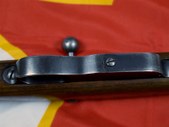
1
Full length view of rifle and common accessories.
| 
2
Full length view of rifle and common accessories.
| 
3
View of the rifle's straight-pull action.
| 
4
View of rear handguard and sight borrowed from the M1924 Mauser.
|

5
Rear stock band. This model is a cavalry carbine and the band is retained with a band spring. Infantry rifle bands are retained with a screw.
| 
6
Nose of the rifle. The M95M retained the M95 front band and stacking rod to make use of available M95 bayonets.
| 
7
Stock wrist. The bolt retains a sling swivel on the reverse side.
| 
8
Buttstock. You can make out the BT3 cartouche in the stock, the acceptance stamp from the Military Technical Institute, in Kragujevac, Serbia - the fore-runner of modern day Zastava Arms.
|

9
Close-up of the BT3 inside a triangle cartouche on the buttstock.
| 
10
Rear sling swivel.
| 
11
Toe of buttstock.
| 
12
Wrist of stock. Note the side-mounted cavalry sling swivel.
|

13
Bottom of magazine assembly. Note the M95M conversion involved welding a steel cover over the original mannlicher clip ejection slot, dressing the cover flush, and refinishing the magazine assembly.
| 
14
Front magazine/trigger guard screw. Note the Yugoslavians numbered both the magazine and the spring housing. On this example they are mismatched. Matching M95M rifles are rare today.
| 
15
Note the dual sling swivel arrangement of the rear stock band.
| 
16
Note the stacking rod and the bayonet lug. This is an underside view of the nosecap.
|

17
Oblique view of the nosecap showing the back of the stacking swivel.
| 
18
muzzle of rifle. Note the barrel is made from an M1924 barrel from the Military Technical Institute at Kragujevac shipped to the Yakov Poshinger Arms and Ammunition Factory with the shank left purposefully long so it could be adapted to the M95 receiver.
| 
19
Buttplate.
| 
20
Note the M1924 front sight assembly.
|

21
Note the cyrillic character (the equivalent of "F") on the front sight base.
| 
22
Note the side sling swivel.
| 
23
Rear sight.
| 
24
Note the Budapest 1909 rollstamp on the receiver designating that the receiver started life as a 1909 contract rifle made in Budapest under contract for Bulgaria. The Bulgarian M95's were captured during the second Balkan War of June 1913.
|

